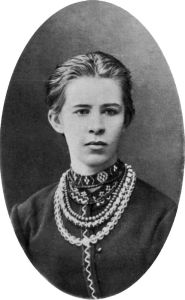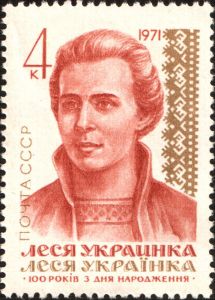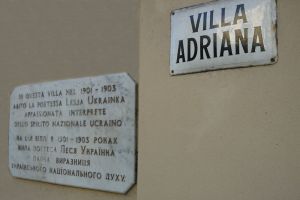Writer and poetess
 Larysa Petrivna Kosac-Kvitka was born in Novograd-Volynskij, Ukraine, on 25 February 1871.
Larysa Petrivna Kosac-Kvitka was born in Novograd-Volynskij, Ukraine, on 25 February 1871.
 Well-known in her homeland under the pseudonym Lesja Ukrainka, so much so that her effigy appears on the 200 Ukrainian hryvnia note, with her poetic works she was a supporter of the dignity and cultural independence of her country.
Well-known in her homeland under the pseudonym Lesja Ukrainka, so much so that her effigy appears on the 200 Ukrainian hryvnia note, with her poetic works she was a supporter of the dignity and cultural independence of her country.
She began writing poetry at an early age: only nine years old she composed Nadija ("Hope"), and had her first poems, Konvalija and Safo, published in 1884. Self-taught, he learned many European languages, Greek and Latin, and several Nordic languages. In 1885, he published his translation of Gogol's works, done together with his brother.
He wrote numerous dramatic works of civil commitment, such as the dramatic poem U katakombach ("In the Catacombs"), which, published in the year of the revolution of 1905, depicts the Ukrainian community, criticising it for its passivity and compromises.
And again, in the dramatic poem Bojarynja ('The Boiarina', 1910) the central theme is Ukrainian hostility to Russian imperialism: here the conviction is expressed that armed struggle is the only way to free the Ukrainian people from the Tsarist Moscow yoke.
Suffering from a severe form of tuberculosis, she travelled around Europe in an attempt to cure herself: Germany, Austria-Hungary, Egypt, and often the Caucasus.
Her constant travelling, however, broadened her cultural horizons considerably and she had the opportunity to experience many things.
 She was also in Italy, spending two years of her life, in 1901 and 1903, in San Remo, in the Villa Natalia (now Villa Adriana), with the Sadovskie family, who often hosted compatriots attracted by the town's climate.
She was also in Italy, spending two years of her life, in 1901 and 1903, in San Remo, in the Villa Natalia (now Villa Adriana), with the Sadovskie family, who often hosted compatriots attracted by the town's climate.
In his letters to his mother and sister, he often spoke of the 'paradisiacal climate' of Sanremo and its climate, from which he evidently benefited.
She described Sanremo and its landscape, in particular the sea, which inspired some of her poems, and the flowers that left Sanremo for Kiev and St Petersburg.
She died in Surami, Georgia, in the region of Shida Kartli, on 1 August 1913.
She is buried in the Baikove cemetery in Kiev.
(sources: from the book "Sanremo e l'Europa, l'Immagine della Città tra Otto e Novecento" edited by Letizia Lodi; ediz. Scalpendi, 2018; Wikipedia)




